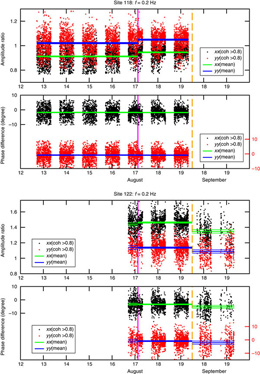Research Abstract
1999年イズミット地震震源破壊帯の電気的状態の急速な変化
Rapid changes in the electrical state of the 1999 Izmit earthquake rupture zone
2013年7月3日 Nature Communications 4 : 2116 doi: 10.1038/ncomms3116

断層帯近傍には地殻流体が存在するが、ゆっくりすべり地震を含む地震を発生させる過程とこの流体との関連性はよく分かっていない。断層帯流体は、電気比抵抗が低いという特徴がある。本論文では、1999年イズミット地震(Mw7.6)の破壊帯における地殻比抵抗の時間依存性を、地震前後に4か所で観測した電磁気学的データを用いて調査した。0.05から2.0 Hzの周波数帯における見かけ比抵抗値の見積もりは、地震時にほぼ数十パーセント突然に減少したことを示している。イズミット地震の1か月後に2か所で得られたデータは、比抵抗値がすでに地震前のレベルに戻っていたことを示している。このような変化は、圧力によって流体が孤立していた状態から連結した状態へと変化したことを示していると解釈できる。データの中には、地震前の変化を示しているものもあり、この変化は大地震前の前震やゆっくりすべり地震と関連性があることを示唆している。
本蔵 義守1, 大志万 直人2, 松島 政貴3, Şerif Barış4, Mustafa Kemal Tunçer5, Sabri Bülent Tank6, Cengiz Çelik7 & Elif Tolak Çiftçi6
- 東京工業大学 火山流体研究センター
- 京都大学防災研究所
- 東京工業大学(大学院)地球惑星科学専攻
- コジャエリ大学(トルコ)
- イスタンブル大学(トルコ)
- ボアズィチ大学(トルコ)
- ボアズィチ大学地震災害軽減センター(トルコ)
Crustal fluids exist near fault zones, but their relation to the processes that generate earthquakes, including slow-slip events, is unclear. Fault-zone fluids are characterized by low electrical resistivity. Here we investigate the time-dependent crustal resistivity in the rupture area of the 1999 Mw 7.6 Izmit earthquake using electromagnetic data acquired at four sites before and after the earthquake. Most estimates of apparent resistivity in the frequency range of 0.05 to 2.0 Hz show abrupt co-seismic decreases on the order of tens of per cent. Data acquired at two sites 1 month after the Izmit earthquake indicate that the resistivity had already returned to pre-seismic levels. We interpret such changes as the pressure-induced transition between isolated and interconnected fluids. Some data show pre-seismic changes and this suggests that the transition is associated with foreshocks and slow-slip events before large earthquakes.

